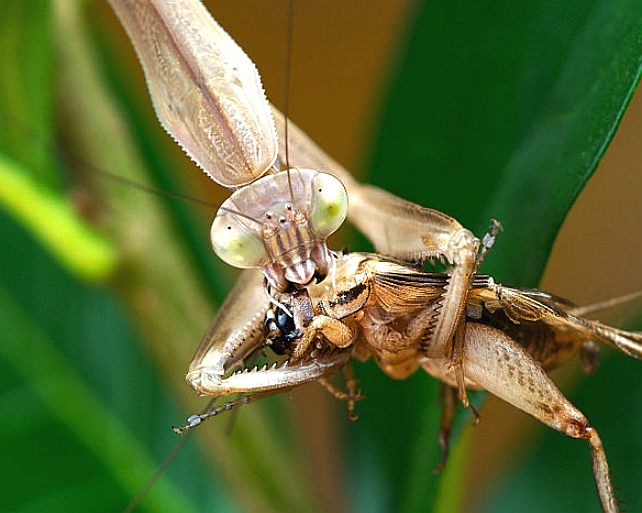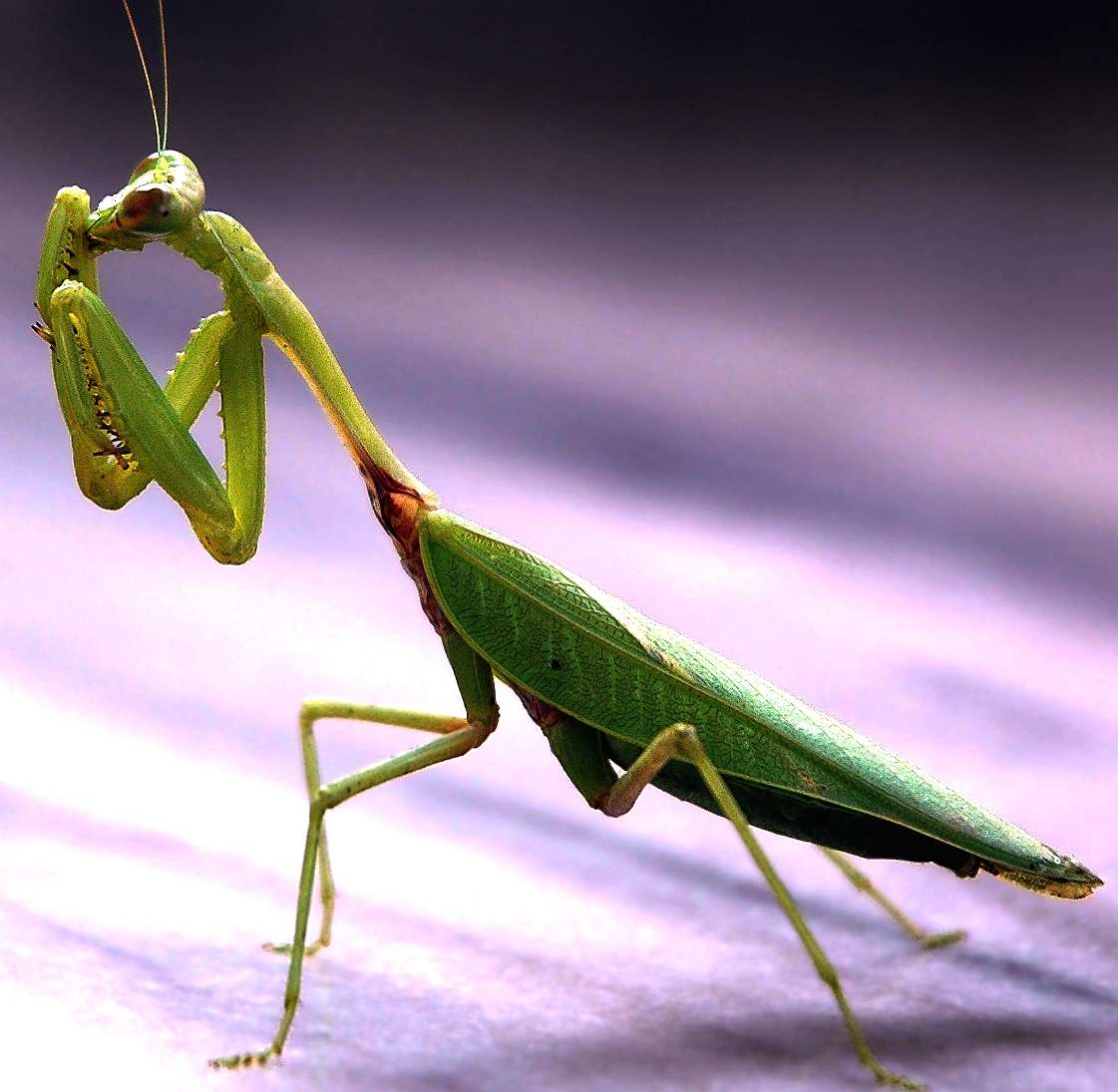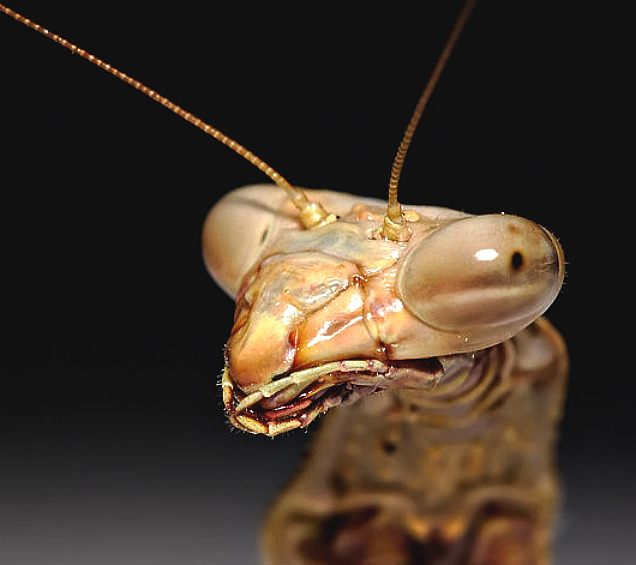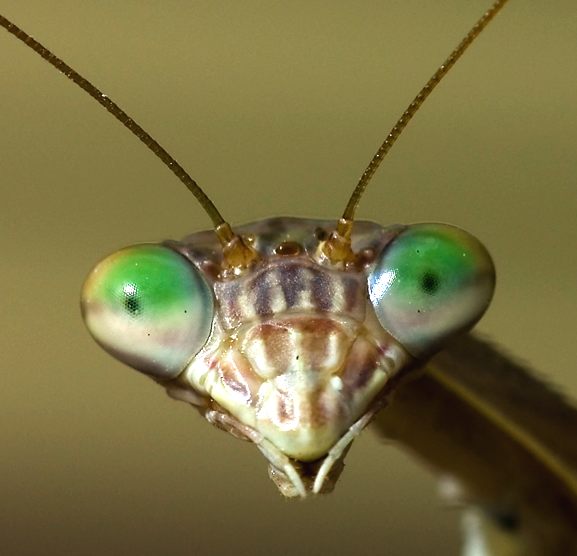
These
stunning creatures attract attention wherever they are seen. The praying
mantis is of the Mantodea order of insects that contains over 2,400 valid species and about 430 genera in 15 families worldwide in temperate and tropical habitats. Most of the species are in the family
Mantidae.
Scientific name: Mantodea
Rank: Order
Higher classification: Dictyoptera
Lower classifications: Liturgusidae, Thespidae, Tarachodidae, More
The English common name for any species in the order is "praying mantis", because of the typical "prayer-like" posture with folded fore-limbs, although the eggcorn "preying mantis" is sometimes used in reference to their predatory habits. In Europe and other regions, the name "praying mantis" refers to only a single species, Mantis
religiosa. The closest relatives of mantises are the termites and cockroaches (order
Blattodea). They are sometimes confused with phasmids (stick/leaf insects) and other elongated insects such as grasshoppers and crickets.
EXTREME MATING - REPRODUCTION and LIFE HISTORY
Sexual cannibalism is common among mantises in captivity, and under some circumstances may also be observed in the field. The female may begin feeding by biting off the male’s head (as they do with regular prey), and if mating has begun, the male’s movements may become even more vigorous in its delivery of sperm. Early researchers thought that because copulatory movement is controlled by a ganglion in the abdomen, not the head, removal of the male’s head was a reproductive strategy by females to enhance fertilisation while obtaining sustenance. Later, this behavior appeared to be an artifact of intrusive laboratory observation. Whether the behavior in the field is natural, or also the result of distractions caused by the human observer, remains controversial. Mantises are highly visual organisms, and notice any disturbance occurring in the laboratory or field such as bright lights or moving scientists. Research by Liske and Davis (1984) and others found (e.g. using video recorders in vacant rooms) that Chinese mantises that had been fed ad libitum (so that they were not hungry) actually displayed elaborate courtship behavior when left undisturbed. The male engages the female in courtship dance, to change her interest from feeding to mating. Courtship display has also been observed in other species, but it does not hold for all mantises.
The reason for sexual cannibalism has been debated, with some considering submissive males to be achieving a selective advantage in their ability to produce offspring. This theory is supported by a quantifiable increase in the duration of copulation among males who are cannibalized, in some cases doubling both the duration and the chance of fertilization. This is further supported in a study where males were seen to approach hungry females with more caution, and were shown to remain mounted on hungry females for a longer time, indicating that males actively avoiding cannibalism may mate with multiple females. The act of dismounting is one of the most dangerous times for males during copulation, for it is at this time that females most frequently cannibalize their mates. This increase in mounting duration was thought to indicate that males would be more prone to wait for an opportune time to dismount from a hungry female rather than from a satiated female that would be less likely to cannibalize her mate. Some consider this to be an indication that male submissiveness does not inherently increase male reproductive success, rather that more fit males are likely to approach a female with caution and escape.
The mating season in temperate climates typically begins in autumn. To mate following courtship, the male usually leaps onto the female’s back, and clasps her thorax and wing bases with his forelegs. He then arches his abdomen to deposit and store sperm in a special chamber near the tip of the female’s abdomen. The female then lays between 10 and 400 eggs, depending on the species. Eggs are typically deposited in a frothy mass that is produced by glands in the abdomen. This froth then hardens, creating a protective capsule. The protective capsule and the egg mass is called an
ootheca. Depending on the species, the ootheca can be attached to a flat surface, wrapped around a plant or even deposited in the ground. Despite the versatility and durability of the eggs, they are often preyed on, especially by several species of parasitic wasps. In a few species, the mother guards the eggs.
As in related insect groups, mantises go through three stages of metamorphosis: egg, nymph, and adult (mantises are among the hemimetabolic insects). The nymph and adult insect are structurally quite similar, except that the nymph is smaller and has no wings or functional genitalia. The nymphs are also sometimes colored differently from the adult, and the early stages are often mimics of ants. A mantis nymph increases in size (often changing its diet as it does so) by replacing its outer body covering with a sturdy, flexible exoskeleton and molting when needed. Molting can happen from five to ten times, depending on the species. After the final molt most species have wings, though some species are wingless or brachypterous ("short-winged"), particularly in the female sex.
In tropical species, the natural lifespan of a mantis in the wild is about 10–12 months, but some species kept in captivity have been sustained for 14 months. In colder areas, females will die during the winter (as well as any surviving males).

DEFENSE and CAMOUFLAGE
Generally, mantises protect themselves by camouflage and concealment. When bothered enough, like when a human pinches their abdomens and moves his hand around them with sudden movements, many mantis species will stand tall and spread their forelegs, with their wings fanning out wide. The fanning of the wings makes the mantis seem larger and more threatening, with some species having bright colors and patterns on their hind wings and inner surfaces of their front legs for this purpose. If harassment persists, a mantis may strike with its forelegs and attempt to pinch or bite. As part of the threat display, some species also may produce a hissing sound by expelling air from the abdominal spiracles. When flying at night, at least some mantises are able to detect the echolocation sounds produced by bats, and when the frequency begins to increase rapidly, indicating an approaching bat, they will stop flying horizontally and begin a descending spiral toward the safety of the ground, often preceded by an aerial loop or spin.
Mantises, like stick insects, show rocking behaviour in which the insect makes rhythmic, repetitive side-to-side movements. Functions proposed for this behaviour include the enhancement of crypsis by means of the resemblance to vegetation moving in the
wind. However, the repetitive swaying movements may be most important in allowing the insects to discriminate objects from the background by their relative movement, a visual mechanism typical of animals with simpler sight systems. Rocking movements by these generally sedentary insects may replace flying or running as a source of relative motion of objects in the visual field. Mantises rock back and forth like the repetitive side-to-side movement when moving while a
human is moving around near the mantis.
DIET and PREDATORY BEHAVIOUR
Most mantises are exclusively predatory and exceptions are predominantly so. Insects form their primary prey, but the diet of a mantid changes as it grows larger. In its first instar a mantid will eat small insects such as tiny flies or its own siblings. In later instars it does not or cannot profitably pursue such small prey. In the final instar as a rule the diet of the praying mantis still includes more insects than anything else, but large species of mantis have been known to prey on small scorpions, lizards, frogs, birds,
snakes, fish, and even rodents; they will feed on any species small enough for them to capture, but large enough to engage their attention. For example, a large mantis feeding on a bee or bug might be pestered with impunity by jackal flies and biting midges that it would readily have eaten in its first instar. Large prey tends to increase in value with the cube of its dimension: a blowfly four times as long as a jackal fly would represent a meal about 64 times as massive. When a female mantis is into her final growth spurt and is accumulating nutrients to make eggs, the largest available prey that she can manage is the most effective for her to concentrate on.
The majority of mantises are ambush predators, but some ground and bark species will actively pursue their prey. For example, members of a few genera such as the ground mantids, Entella, Ligaria and Ligariella, run over dry ground seeking prey much as tiger beetles do. Species that are predominantly ambush predators camouflage themselves and spend long periods standing perfectly still. They largely wait for their prey to stray within reach, but most mantises will chase tempting prey if it strays closely enough. In pure ambush mode a mantis lashes out at remarkable speed when a target does get within reach, details of the speed and mode attack varying with the species. A mantis will catch prey items and grip them with grasping, spiked forelegs. The praying mantis usually holds its prey with one arm between the head and thorax, and the other on the abdomen. Then, if the prey does not resist, the mantis will eat it alive. However, if the prey does resist, the mantis will often eat it head first, some species of mantises being more prone to the behaviour than others. Unlike sucking predatory arthropods, a mantis does not liquefy prey tissues or drain its prey's body fluids, but simply slices and chews it with its mandibles as convenient, often from one end. If it should happen to have begun feeding on the midsection of the prey it typically ends up eating first one remnant end from one foreclaw then the rest from the other, leaving nothing but accidentally severed fragments such as limbs.
Chinese Mantids have been found to gain benefits in survivorship, growth, and fecundity by supplementing their diet with pollen. In replicated laboratory tests the first instar actively fed on pollen just after hatching, thereby avoiding starvation in the absence of prey. The adults fed on pollen-laden insects, attaining fecundity as high as those fed on larger numbers of insects alone.

EVOLUTION
One theory for the evolution of the group is that mantises evolved from proto-cockroaches, diverging from their common ancestors by the Cretaceous period, possibly from species like Raphidiomimula burmitica, a predatory cockroach with mantis-like forelegs. Possibly the earliest known modern mantis is Regiata scutra, although more common (and confirmed) is Santanmantis, a stilt-legged genus, also from the Cretaceous. Like their close termite cousins, though, mantises did not become common and diverse until the early Tertiary period.

ANATOMY and MORPHOLOGY
Mantises have two grasping, spiked forelegs ("raptorial legs") in which prey items are caught and held securely. In most insect legs, including the posterior four legs of a mantis, the coxa and trochanter combine as an inconspicuous base of the leg; in the raptorial legs however, the coxa and trochanter combine to form a segment about as long as the femur, which is a spiky part of the grasping apparatus (see illustration). Located at the base of the femur are a set of discoidal spines, usually four in number, but ranging from zero to as many as five depending on the species. These spines are preceded by a number of tooth-like tubercles, which, along with a similar series of tubercles along the tibia and the apical claw near its tip, give the foreleg of the mantis its grasp on its prey. The foreleg ends in a delicate tarsus made of between four and five segments and ending in a two-toed claw with no arolium and used as a walking appendage.
The mantis thorax consists of a prothorax, a mesothorax, and a metathorax. In all species apart from the genus Mantoida, the prothorax, which bears the head and forelegs, is much longer than the other two thoracic segments. The prothorax is also flexibly articulated, allowing for a wide range of movement of the head and forelimbs while the remainder of the body remains more or less immobile. The articulation of the neck is also remarkably flexible; some species of mantis can rotate the head nearly 180 degrees.
Mantids may have a visual range of up to 20 metres. Their compound eyes may comprise up to 10,000 ommatidia. The eyes are widely spaced and laterally situated, affording a wide binocular field of vision) and, at close range, precise stereoscopic vision. The dark spot on each eye is a pseudopupil. As their hunting relies heavily on vision, mantids are primarily diurnal. Many species will however fly at night, and then may be attracted to artificial lights. Nocturnal flight is especially important to males in search of less-mobile females that they locate by detecting their pheromones. Flying at night exposes mantids to fewer bird predators than diurnal flight would. Many mantises also have an auditory thoracic organ that helps them to avoid bats by detecting their echolocation and responding evasively.
Mantids can be loosely categorized as being macropterous (long-winged), brachypterous (short-winged), micropterous (vestigial-winged), or apterous (wingless). If not wingless, a mantis will have two sets of wings: the outer wings, or tegmina, are usually narrow, opaque, and leathery. They function as camouflage and as a shield for the hind wings. The hind wings are much broader, more delicate, and transparent. They are the main organs of flight, if any. Brachypterous species are at most minimally capable of flight, other species not at all. Even in many macropterous species the female is much heavier than the male, has much shorter wings, and rarely takes flight if she is capable of it at all.
The abdomen of all mantises consist of ten tergites with a corresponding set of nine sternites visible in males and seven visible in females. The slim abdomen of most males allows them to take flight more easily while the thicker abdomen of the females houses the reproductive machinery for generating the ootheca. The abdomen of both sexes ends in a pair of cerci.


MANTIS
MILITARY
VEHICLES
'Mantis'
is also the name of an ROV used in connection with the Dragonfly mine
hunter ship, that operates with a partly submerged hull, so just like the
dragonfly insect, it interfaces with air and water during its life cycle. The Dragonfly
is suitable for military (NATO) peacekeeping
operations such as mine hunting and persistent surveillance, where
economic considerations dictate flexible autonomous survey, rather than
brute force battleship presence.
Another
vehicle that takes its name from the very art-form insect, is the
mechanical walking robot seen above and right, designed by engineer Matt
Denton. Though it must be said that the Mantis hexapod
is not at all attractive, unlike its biological namesake. The Mantis is
more spider-like in the way it moves, despite not having eight legs.
Matt's particular skill is in making his robots move realistically. In
that programming he is a master.





